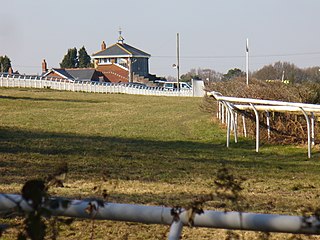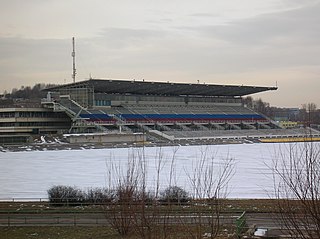
Stockholm Olympic Stadium, most often called Stockholms stadion or simply Stadion, is a stadium in Stockholm, Sweden. Designed by architect Torben Grut, it was opened in 1912, its original use was as a venue for the 1912 Olympic Games. At the 1912 Games, it hosted the athletics, some of the equestrian, some of the football, gymnastics, the running part of the modern pentathlon, tug of war, and wrestling events. It has a capacity of 13,145–14,500 depending on usage and a capacity of nearly 33,000 for concerts.

Bromont is a city in southwestern Quebec, Canada, at the base of Mont Brome; it is in the Brome-Missisquoi Regional County Municipality. The Bromont area and its resort, Ski Bromont, is well known as a tourist destination for its downhill skiing, mountain biking, BMX-riding and water slides. It also features golf and equestrian events in moderate weather. Bromont also boasts a high-tech industrial park, which includes IBM, General Electric, and Teledyne DALSA. Bromont Airport serves the region.

Centre Pierre Charbonneau is a sports arena located at Olympic Park in Montreal, Quebec, Canada. It was built in 1957 and holds 2,700 people. It is the former home of the Montreal Jazz of the National Basketball League of Canada. It was formerly host to the Montreal Royal of the American Basketball Association's current incarnation, and the Montreal Sasquatch of the Premier Basketball League.
Municipal Stadium is a multi-purpose stadium in Sherbrooke, Quebec, Canada. It is used mostly for football and hosted three football games during the 1976 Summer Olympics. It holds 4,000 people.

For the 2000 Summer Olympics, a total of thirty sports venues were used. After Melbourne hosted the 1956 Summer Olympics, Australia made several bids for the Summer Olympics before finally winning the 2000 Summer Olympics by two votes over Beijing, China. Venue construction was set at the Homebush Bay area of Sydney in an effort to rehabilitate the land. Environmental studies of the area in the early 1990s forced remediation to be used for about a fifth of the site selected. Fifteen new venues were constructed for the Games. Many of the venues used for the 2000 Games continue to be in use as of 2020, although some of the pre-existing facilities have been demolished and replaced.

The Montreal Olympic Pool was constructed for the 1976 Summer Olympics as part of the Montreal Olympic Park. The Olympic Pool is part of the larger swimming centre, located in the base of the inclined Montreal Tower. The centre has a spectator capacity of 3,012 seats.
St. Michel Arena is a 2,000-seat indoor arena in Montreal, Quebec, Canada that was built in 1968. It served as the weightlifting venue of the 1976 Summer Olympics and is located about 4.4 km west of the Olympic Stadium. The capacity was temporarily raised to 2,700 for the games.

Tweseldown Racecourse in Fleet, Hampshire was originally a National Hunt steeplechasing venue and the home of the equestrian dressage and eventing competitions in the 1948 Summer Olympics.

The Olympic Village is a twin-tower structure in Montreal, Quebec, Canada, built as the athletes' residence for the 1976 Summer Olympics. Designed by architects Roger D'Astous and Luc Durand, it was built massively over budget by a consortium of architects, including Joseph Zappia, who was later convicted of fraud in connection with his involvement with the building.
The Olympic Shooting Range, L'Acadie was a temporary firing range located in L'Acadie, Quebec. For the 1976 Summer Olympics held in neighboring Montreal, it hosted the shooting and the shooting part of the modern pentathlon events.

The Trade Unions' Equestrian Complex is an equestrian venue located near the Bitsa Park in the South District of Moscow city, Russia. During the 1980 Summer Olympics, it hosted the riding and running portions of the modern pentathlon events and all of the equestrian events except individual jumping.
The Club Hípic El Montanyà is a Spanish horse club. For the 1992 Summer Olympics in neighboring Barcelona, it hosted the equestrian dressage and the cross country part of the eventing competitions.

Kazakoshi Park Arena is an indoor arena located in Karuizawa, Nagano, Japan. Constructed in 1990 with an opening ceremony taking place in 1996, it hosted the curling competition for the 1998 Winter Olympics in Nagano. Because it was in Karuizawa, the town became the first venue to host events at both the Summer and Winter Olympics. At the 1964 Summer Olympics in Tokyo, Karuizawa hosted the equestrian events.
For the 1956 Summer Olympics, events were staged in a total of thirteen sports venues in Melbourne, Victoria, one in Ballarat, Victoria, and three sports venues in Stockholm, Sweden. The equestrian events took place in Stockholm in June 1956, due to Australia's strict quarantine laws on equestrianism, and the other Olympic events took place in Melbourne later in the year, between late November and early December.

For the 1980 Summer Olympics, a total of twenty-eight sports venues were used. The first venue used for the Games was built in 1923. With the creation of the Spartakiad in Moscow in 1928, more venues were constructed. Central Lenin Stadium Grand Arena was built in 1956 for that year's versions of the Spartkiad. A plan in 1971 to construct more sports venues by 1990 was initiated, but accelerated in 1974 when Moscow was awarded the 1980 Games. The new venues to be used for the Games were completed in 1979. During the Games themselves at the permanent road cycling venue, the first ever constructed, the largest margin of victory was recorded in the individual road race cycling event since 1928. The Grand Arena hosted the football final that was played in a rainstorm for the third straight Olympics. After the 1991 break of the Soviet Union, the venues in Kiev, Minsk, and Tallinn would be located in Ukraine, Belarus, and Estonia, respectively. Luzhniki Stadium, formerly Grand Arena, continues to be used, and it was affected by the Luzhniki disaster in 1982. The stadium served as host for the IAAF World Championships in Athletics in 2013. Another venue, the Moscow Canoeing and Rowing Basin, served as host to the ICF Canoe Sprint World Championships in 2014. In December 2010, Russia was awarded the 2018 FIFA World Cup with Luzhniki Stadium and Dynamo Stadium proposed as venues for those events.
The individual dressage event was one of six equestrian events on the Equestrian at the 1992 Summer Olympics programme. The competition was held at the Olympic Equestrian Centre in Bromont, Quebec.










